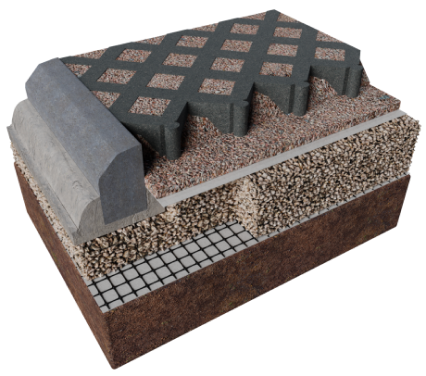Sustainability
Concrete pavements exhibit a range of characteristics that contribute to their sustainability within transportation infrastructure. These attributes are rooted in their design, material composition, and performance over their lifecycle. Key aspects that underscore the sustainability of concrete pavements include:
Durable
Framework
Concrete pavements are renowned for their inherent durability, which arises from their ability to withstand heavy loads, resist abrasion, and endure environmental stresses. The exceptional load-bearing capacity and resistance to fatigue and deformation ensure extended service life, reducing the frequency of maintenance interventions and consequent resource consumption.

Longevity and Life-
Cycle Analysis
The extended operational life of concrete pavements, often spanning several decades, results in decreased resource demand for reconstruction or resurfacing. Life-cycle assessments consistently demonstrate that the initial energy and resource investment in concrete pavement construction is offset by reduced long-term maintenance, repair, and replacement needs, culminating in a net environmental benefit

Material and
Sourcing
Concrete's primary constituents—cement, aggregates, water—are widely available and sourced locally in many cases. This localized procurement reduces transportation-related emissions and diminishes reliance on distant resources, consequently minimizing associated carbon footprints.

Recycling and
Reuse
As part of sustainable pavement practices, concrete pavements can incorporate recycled materials, such as crushed concrete and supplementary cementitious materials, thereby reducing demand for virgin resources and curbing waste generation.
The integration of recycled materials contributes to the conservation of natural resources and diminishes landfill burdens.

Permeable and Porous Concrete
Innovations in concrete pavement design encompass the integration of permeable or porous concrete formulations. These variants facilitate stormwater infiltration, mitigating runoff-related issues, recharging groundwater, and enhancing overall water management strategies in urban environments
Energy Effectively and Reflectively
Concrete pavements exhibit high solar reflectance due to their light coloration. This property diminishes solar heat absorption, mitigating the urban heat island effect and curtailing energy expenditures on cooling in warm climates. Furthermore, the enhanced reflectivity enhances nighttime visibility, potentially leading to reduced energy consumption associated with roadway lighting


Longevity and Life-Cycle Analysis
The extended operational life of concrete pavements, often spanning several decades, results in decreased resource demand for reconstruction or resurfacing. Life-cycle assessments consistently demonstrate that the initial energy and resource investment in concrete pavement construction is offset by reduced long-term maintenance, repair, and replacement needs, culminating in a net environmental benefit
Under Water Sensitive Urban Planning Permeable pavements is one of the major form of recharge structure:
Alternative to typical impermeable pavements, allowing run-off to percolate through hard surface to underground granular sub-base reservoir for storage.These systems reduce the volume of water directed to municipal system and are viable for storm water management

Permeable pavements reduce runoff and improve the quality of water returning to the environment